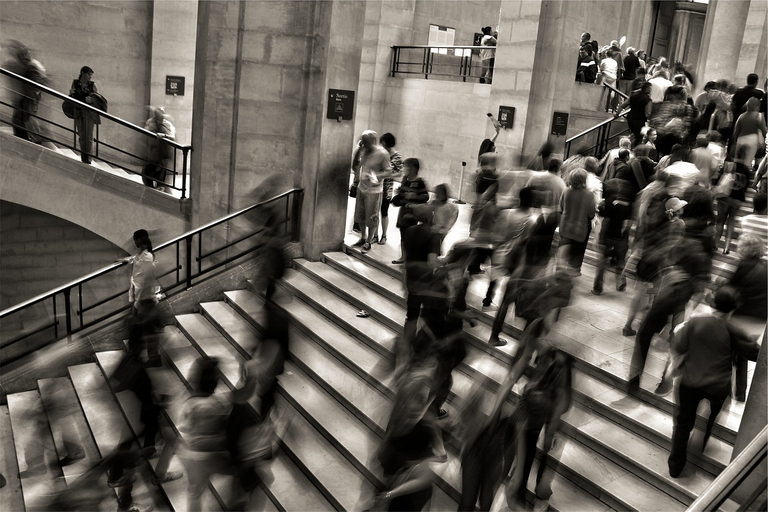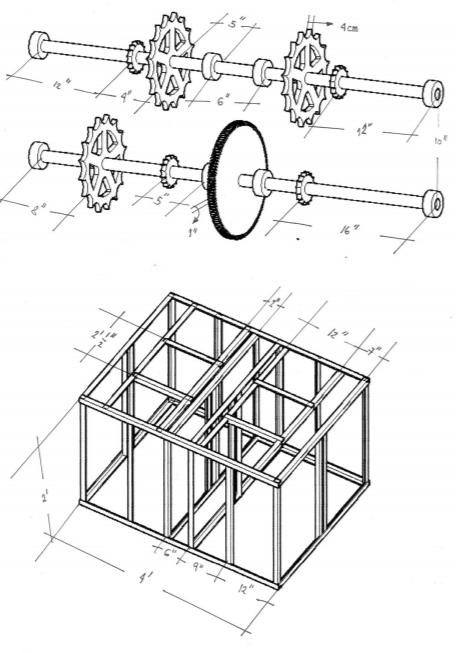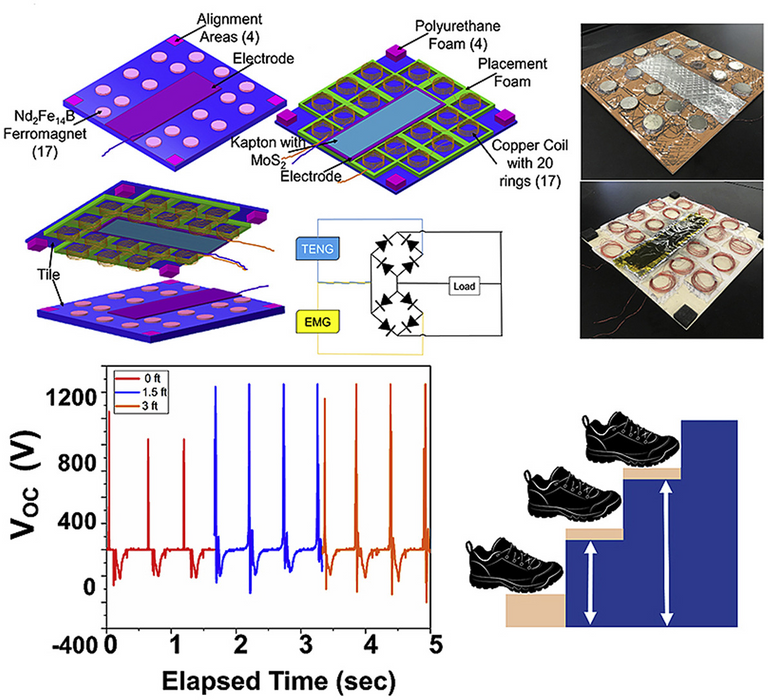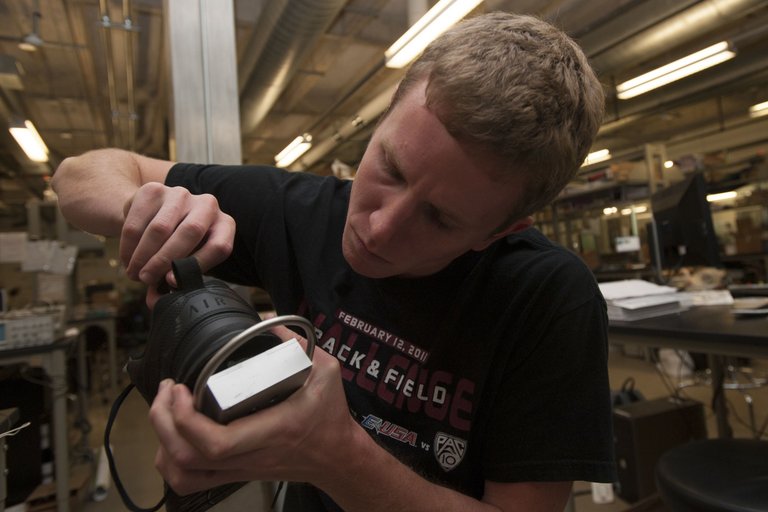Can we get usable electricity from our footsteps?

A crowded train station. pixabay
When I was in college, I did a project study for electricity from footsteps with three friends. We had a hard time building the project from scratch, and luckily way made it. I remember this project when I was cleaning my storage at home. I found my old drafts lying in the corner, and it picked my interest to read the papers. I am fascinated with unconventional means of generating electricity until now. I read a lot of literature about electricity from footsteps, and I want to find out if this technology is present today.
In 2007, James Graham and Thaddeus Jusczyk envisioned harvesting human movement from train stations or concerts. They want to turn walking into usable electricity. They created a responsive subflooring where a slight human step depresses a block that slips across one another to generate electricity. Gramham and Jusczyk translate translational motion produce by a human into a rotation in a dynamo.
They installed the Crowd Farm in Boston's South Station, which they observed that a single step power up to two 60W light bulbs unsteadily in a second. Gramham and Jusczyk estimated that 28,527 steps power up a moving train for a second. They added that the Crowd Farm is for urban centers with concentrated human traffic. Populated countries like China, India, and the Philippines can benefit from this system.

A sketch from the harvester that we made before.
The harvester we created in our project study is a similar concept to what Graham and Jusczyk except we did not integrate it into the flooring. We have a stepping board that we linked into a flywheel. When someone steps on the board, the flywheel rotates the dynamo to produce electricity. We used a 5W lightbulb to show that the system works.
We found out that a person's mass affects how much electricity we get from the system. A person who weighs over 60 kg can produce as much as 10W per step in an instance; however, it is not constant. In contrast, a person who weighs less than 30 kg can not generate electricity in our system. Our project study only focuses on generating electricity from footsteps, and we did not implement it for wide-scale testing.
In 2019, the researchers from Malaysia developed a system to generate electricity from footsteps using a similar concept. Their devices have a stepping board link to a flywheel, and the flywheel drives a dc motor. Their system allows kids and adults that weigh 15kg to 55 kg. They have similar observations concerning the relation between weight and power. People who weigh 55kg to 59kg generate 0.29W while 15kg to 19kg produce 0.0603W.
They concluded that it is feasible to generate electricity from our footsteps. They added that a simple rack and pinion mechanism performs the task. They elaborated that the generated power increases proportionally to the weight of a person. A person with a body mass of around 55kg can effectively generate electricity.

Piezoelectric Tile. open access, CC
Other people developed a system using a piezoelectric transducer to convert the steps into electricity. The idea of this technology is to use the pressure change caused by people walking on top of the transducer. In contrast, the previous method relies on how the translational motion drives a flywheel to generate electricity from human steps. The use of piezoelectric transducer in harvesting electricity from our footsteps eliminates the need for complex and bulky mechanical structures. We can make floor mats embedded with a piezoelectric transducer.
In 2018, Berlian, Darlis, and Suraatmagja designed a tile to generate electricity from footsteps. The tile has a rubber mat, acrylic, and piezoelectric transducers. The tile has a rubber-covered acrylic plate, and beneath it is the piezoelectric transducers. They connected the piezoelectric transducer in series and parallel to maximize the electricity output from each step.
Berlian, Darlis, and Suraatmagja took an initial measurement by allowing a 60kg person to run in place for 30 seconds. These results in different maximum pulses and the output voltage. They create 20 pieces and connected them in parallel. They register 63.98V from the floor tile when a person weighing 60 kg walks on top of it. The maximum voltage is 71.20V. They concluded that the piezoelectric transducer has the potential to be an energy harvester from footsteps.
Iqbal Mahmud from Bangladesh introduced a new approach to generate electricity from footstep. Instead of having a mechanical and piezoelectric setup, He uses fluid pressure to harvest the electricity from footsteps. His prototype has a pipe, nozzle, unidirectional valve, water reservoir, and a small generator. He created footwear with water cushioned soles so that when the user steps, the water pressure in the cushion changes and causes the water to stream to the turbine. When the turbine rotates, the small generator induced electricity.
Mahmud used three sizes of a turbine to test the output of his prototype. Based on his experimental results, the larger turbine produced higher power output and efficiency. He pointed out that the system can't maintain a constant speed for the whole duration, which I think consistent with the other system mentioned so far. He added that the voltage variation is prevalent in operation, and it needs a voltage regulator. He concluded that harvesting electricity from footstep is viable.
What we have so far is a system for urban application. I understand that it can't be sustainable with usage if we don't create a steady output. With that in mind, I dig deeper into the subject and check if there are attempts to use it to charge mobile phones.
There are studies in creating tiles and soles that generate electricity from our footsteps. The researcher from the University of Wisconsin-Madison devised a technique to harvest that can practically get large forces from footfalls even with small displacement. They did it by combining reverse electrowetting with a novel device. Their device is called a bubbler.
What unique about the bubbler is it doesn't have a moving part which makes it slimmer than the usual mechanical counterparts. The bubbler contains two plates with conductive liquid in between. It has tiny holes at the bottom that allows pressurized gas to pass through so that bubbles can form bubbles. These bubbles grow in size, and its rapid burst washes the conductive fluid to generate electricity. The bubbler offers a high power density.

Tyler Wiest attaches a PediPower to a shoe for a demonstration. open access
A team from Rice University developed a shoe sole mounted generator that harvests electricity while you are walking. They called it PediPower. They designed the PediPower after carefully studying the force distribution during walking. They found out the heel makes the first contact to the ground when walking. So, they attached the PediPower at the shoe's heel.
The prototype features an arm attached around the shoe's heel and links to a gearbox. When the arm hits the ground, it moves up to actuate the gears in the gearbox. The gears drive a motor to generate electricity, which charges the battery pack at the belt. They placed the at the side of the shoe.
A lot of development since I last time read about electricity from footsteps. New harvester is more scalable for day-to-day use rather than the ones that focus on an urban setting. Previously, mechanical and piezoelectric design prevails in the literature of electricity from footsteps. Today, we can see a lot of new ways to harvest electricity from human activity. Some prototypes focus on shoes that may power our mobile phones and gadget.
References
- MIT duo sees people-powered "Crowd Farm": Plan would harvest energy of human movement
- Electricity From Footsteps
- Development of a footstep power generator in converting kinetic
energy to electricity - Green energy harvesting from human footsteps
- Power Generation Through Footsteps Using Piezoelectric Sensors Along with GPS Tracking
- A review of walking energy harvesting using piezoelectric
materials - Footstep Power Generation Using Piezo Electric Transducers
- Electrical Power Generation Using Footsteps
- Power walk: Footsteps could charge mobile electronics
- Kinetic energy-harvesting shoes a step towards charging mobile devices on the go
- PediPower device brings kinetic energy to heel
- Footsteps Can Generate Enough Power To Charge Devices
- Smart shoe devices generate power from walking
https://twitter.com/juecoree/status/1368197467263528966
I've seen a couple of shoe soles that generate electricity enough to charge mobile gadgets. Hunted them during my days in the steemhunt project.
That would be extremely helpful/convenient. Being able to charge/recharge your phone by literally walking around. I wonder how cost-effective they could make it at this point or how much further it has to go? You'd think they could at least make it so that you could charge rechargeable batteries for other gadgets that use them. Very interesting....